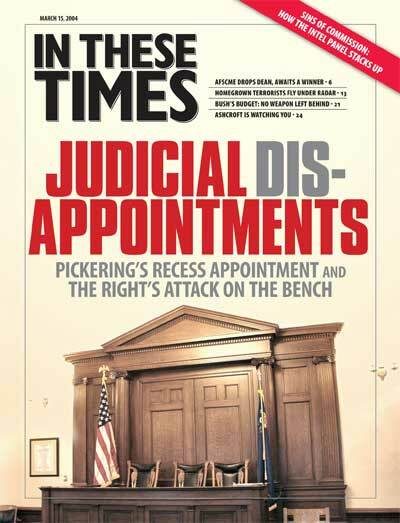
The presidential election this fall may hinge on what happens to people like John Mahoney and Robert Daems. Both are in their 50s, lost their jobs in December 2002 and still haven’t found work. If President Bush continues to oppose renewing federal extended unemployment benefits, their compensation soon will run out.
“I don’t think the Republican Party even cares,” says Daems, who worked for Intel as a systems analyst in Phoenix. “I even feel the Democratic candidates don’t have an understanding of what’s happening out there.”
A Democrat could win in November, however, if he can prove to Daems and other voters that he understands and can manage the economy better than Bush. Polls show that the economy is now the top issue with voters, roughly half of who rank unemployment as their major economic concern.
Both parties show strengths — the Democrats on Social Security, healthcare and the federal budget and Republicans on national security and terrorism — according to a review of polls by Democracy Corps, a Democratic strategy group.
But there is no clear advantage for either party on jobs and prosperity.
Despite signs of growth and a stock market rebound, this has been the weakest economic recovery since World War II. Even though the Bush recession officially ended in November 2001, the economy continued to lose about 700,000 jobs through last September. Jobs have grown by an average of 76,000 a month since then, but that’s still half the number needed to account for new workers. It’s also a far cry from what Bush promised his tax cuts would deliver. The Economic Policy Institute (EPI) calculates that Bush has fallen short by 1.85 million jobs.
Rigged numbers
The traditional signal of distress — the unemployment rate — has been surprisingly low, dropping by one-tenth of a percent in January to 5.6. But the figure is misleading. Many discouraged workers have simply dropped out of the labor force. The percentage of men in the workforce, for instance, dropped by about as much in the last three years as it did over the previous 20. At the same time, workers like Daems and Mahoney — an auto parts factory worker in Battle Creek, Michigan — are remaining out of work much longer than normal and long-term unemployment, more than 27 weeks, has increased most rapidly for workers with at least a college degree. As a result, a record number of unemployed workers in January lost unemployment benefits, according to the Center on Budget and Policy Priorities, plunging roughly half into poverty.
But the problem isn’t simply the loss of 2.4 million jobs since the recession started — the greatest sustained job loss since the Great Depression, according to EPI — and anemic jobs creation. There’s also a shift for the worse in the kinds of jobs available. On average, the jobs being lost pay 21 percent more than those in growth industries, says EPI researchers Michael Ettlinger and Jeff Chapman.
The long period of job loss also is taking its toll on people who are still employed: Real hourly wages fell for middle- and low-wage workers last year even as economic output grew, says Jared Bernstein and Lawrence Mishel of EPI. But not everyone lost out. Profits have grown dramatically, claiming a share of the growth in the corporate sector more than double the average of past recoveries.
Skewed stimulus
This reprises a familiar theme for the Bush regime: Most workers are worse off whether they have a job or are unemployed, and big corporations are profiting. But it should be no surprise. It was designed that way.
“When they passed the tax cuts, every economist argued this is not how you structure a stimulus,” Bernstein says. “You can’t expect to stimulate job growth by cutting taxes on dividends and capital gains and failing to implement direct spending on job creation, fiscal assistance to the states and other spending.”
There were several fatal flaws in Bush’s plan, but it was not the swing from a big budgetary surplus to deep deficits. It makes sense for the federal government to run a deficit in a recession to provide economic demand that sustains employment. But the Bush tax cuts were skewed to the rich, not low- and moderate-income workers and the unemployed, who needed the aid and would immediately spend it. Bush was simply determined to cut taxes for the rich. First he justified it as returning the surplus to taxpayers. When the recession deepened, he justified the same policy as a stimulus.
Instead of tax cuts, the government should have directly aided the states more and invested in public needs that build economic strength. Finally, the stimulus should have been immediate and short-term. Even during a hoped-for recovery, creating endless huge budget deficits solves nothing.
Bush’s disastrous policies largely are responsible for the long jobless recovery, but some analysts recently have argued that fewer jobs have been created because productivity has grown so fast. But Bernstein notes that productivity has been growing only slightly faster than normal. The problem is not productivity, he argues, but a demand for goods and services that is far below the average.
Certainly, productivity increases do not adequately account for the 42 consecutive months of manufacturing job losses — 2.6 million gone since Bush took office. Global economic forces play a role. For example, some stimulus leaks to other countries as Americans buy imports. The trade deficit has grown sharply since 2000, from 3 percent to 5 percent of gross domestic product, reflecting a loss of potential jobs in the United States.
Dan Luria, vice president of the Michigan Manufacturing Technology Consortium, argues that there have been real productivity increases, even in the service sector, but some of that reflects improperly measured use of cheap inputs from abroad.
In addition, nobody accurately measures how many jobs are lost to offshoring. But even as demand grows, multinationals are shipping jobs out. In January, for example, Electrolux announced that it would move most of the 2,700 jobs at its Greenville, Michigan, refrigerator factory to Mexico. More than 8,000 jobs in the Greenville area are likely to be lost as a result.
Mounting debt
Several indicators suggest there may not be the turnaround in job creation Bush wants for his reelection campaign. The administration continues to rely on tax cuts for the rich that already have proved ineffective. Investors also are wary that persistent deficits and a declining dollar will lead to inflation and higher interest rates, which would slow growth.
With real wages declining for many, workers won’t be able to spend more and stimulate job growth. Already many households are dangerously deep in debt, since home refinancing and other debts have been major props to the economy in recent years. These debt-ridden families will be vulnerable to rising interest rates and any bursting of the housing bubble.
Even with continued growth, Bush almost certainly will be running as the first president since Herbert Hoover to finish a term with a job deficit.
Democratic alternatives have had their own flaws. Howard Dean overemphasizes the dangers of deficits, making his record of balancing Vermont’s budget and a pledge to balance the federal budget the economic centerpiece of his campaign. John Kerry relies too heavily on tax cuts, such as his proposals to cut business taxes for creating new jobs rather than direct public spending to stimulate the economy.
But a modestly populist economic alternative is emerging from the Democratic presidential contest, including proposals for creating fairer trade, supporting unions, aiding small businesses and manufacturing, restructuring taxes more progressively, spending more for education and research, investing in energy efficiency and alternative energy, budgeting more responsibly, improving infrastructure and moving toward universal healthcare.
It’s not adequate, by any means. But it beats Bush’s policy, both in fairness and economic effectiveness, and it may politically beat Bush as well.
David Moberg, a former senior editor of In These Times, was on staff with the magazine from when it began publishing in 1976 until his passing in July 2022. Before joining In These Times, he completed his work for a Ph.D. in anthropology at the University of Chicago and worked for Newsweek. He received fellowships from the John D. and Catherine T. MacArthur Foundation and the Nation Institute for research on the new global economy.









